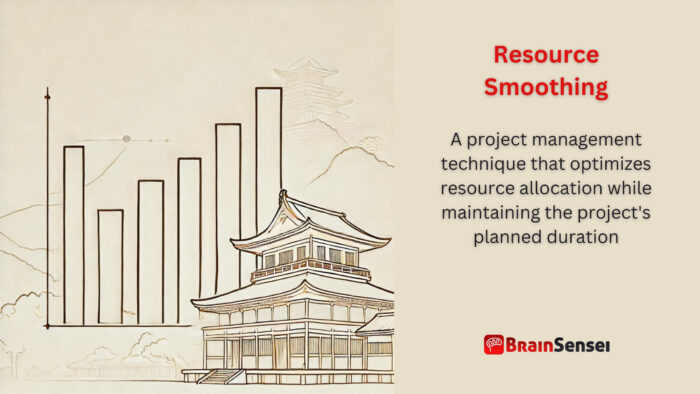
Resource Smoothing
What is Resource Smoothing?
Resource smoothing is a project management technique that optimizes resource allocation while maintaining the project’s planned duration. It ensures resource usage stays within predefined limits, avoiding peaks and troughs without delaying project milestones. Unlike resource levelling, which may extend project duration, resource smoothing adjusts activities within their float to achieve balanced workload distribution.
Key Takeaways
- Resource smoothing prevents resource overallocation while maintaining the original project timeline.
- It differs from resource levelling, which may alter the project’s duration to resolve conflicts.
- This technique helps avoid burnout, inefficiencies, and resource bottlenecks.
- It applies to various industries, including construction, IT, and healthcare.
- Project managers use tools like Gantt charts and workload balancing to implement resource smoothing.
Understanding Resource Smoothing
How It Works
Resource smoothing involves distributing work evenly across available resources without affecting critical path activities. Project managers analyze resource allocation and adjust non-critical activities to prevent spikes in demand. By keeping resource utilization consistent, teams can improve efficiency and reduce risks associated with overburdening personnel or equipment.
Key Aspects of Resource Smoothing
- Uses Activity Float: Adjusts task start or end times within available slack.
- Maintains Project Schedule: Unlike resource levelling, it does not impact the project’s end date.
- Reduces Variability: Helps avoid resource shortages or surpluses.
- Optimized Workload: Prevents excessive overtime or underutilization.
Common Challenges
- Limited Flexibility: Works if activities have float.
- Complexity in Large Projects: Requires detailed planning to balance resources effectively.
- Dependence on Accurate Estimates: Requires precise task duration and resource requirements.
Related Terms
- Resource Leveling: A technique that adjusts project schedules to resolve resource conflicts, potentially extending the project duration
- Critical Path Method (CPM): A project scheduling approach that identifies the most extended sequence of dependent tasks
- Float (Slack Time): The amount of time a task can be delayed without affecting project completion
- Workload Balancing: Evenly distributing work among team members to enhance efficiency
- Capacity Planning: Determining the resources required to meet project demands effectively
Examples of Resource Smoothing
Construction Industry
A construction company working on a commercial building project notices that electricians are overbooked in certain weeks. The project manager redistributes electrical work across available float without delaying structural work, ensuring consistent workload distribution. This helps avoid inefficiencies and maintains productivity without extending deadlines.
For example, during the electrical installation phase, the team initially scheduled 15 electricians to work full-time for three weeks. However, due to dependencies with plumbing and HVAC installations, electricians had to wait for other teams to finish specific tasks. The project manager, recognizing these dependencies, spread the workload across six weeks using an available float in the schedule. This change prevented electricians from being idle in certain weeks while being overburdened in others. Consequently, the project continued as planned, minimizing resource waste and reducing overtime costs.
IT and Software Development
In a software development project, front-end designers are scheduled for intensive work in one sprint and underutilized in another. The project manager smooths out their workload by shifting non-urgent UI enhancements across sprints while maintaining the project deadline.
A software company developing a new mobile application encountered this challenge. Initially, front-end designers were overloaded during the first three sprints due to the high demand for interface development. However, their workload significantly decreased during the final sprints as backend integration and testing took priority. To avoid inefficient resource allocation, the project manager redistributed tasks such as refining animations, improving accessibility features, and conducting additional user experience (UX) testing across later sprints. This redistribution balanced the workload and enhanced team morale without impacting the release date.
Additionally, the project manager reduced last-minute revisions and bottlenecks in the testing phase by implementing resource smoothing. Instead of overburdening developers towards the end, they proactively handled UI refinements early, resulting in a higher-quality product at launch.
Healthcare Industry
A hospital implementing an electronic health records (EHR) system finds its IT staff overburdened during the rollout. The project manager adjusts training sessions within the available time frame, preventing burnout while ensuring the system launches on time.
For instance, a major hospital system in the United States planned to transition from paper records to a fully digital system within six months. During the initial phase, IT staff were overwhelmed with configuring software, addressing security concerns, and ensuring compatibility with existing infrastructure. Simultaneously, medical personnel required training on the new system.
Initially, training sessions were planned within a short four-week window, overlapping with critical IT deployment tasks. This scheduling led to staff shortages and delays. The project manager used resource smoothing to resolve this issue by extending training sessions across eight weeks and using available Slack for non-critical activities. This adjustment allowed IT staff to provide training without compromising system deployment. The project met both objectives efficiently.
Moreover, spreading out training helped reduce staff fatigue and improved user adoption rates. Medical professionals had more time to familiarize themselves with the system, leading to a smoother transition and fewer post-implementation support issues.
These real-world examples highlight how resource smoothing enhances efficiency across industries. By strategically adjusting workloads, project managers can prevent burnout, optimize resource utilization, and maintain project schedules.
Use Cases of Resource Smoothing
United States (Renewable Energy Project)
A renewable energy company in California was constructing a solar farm with multiple contractors, engineers, and electricians working on various phases. The original schedule had significant peaks in labour demand, leading to inefficient resource use. The project manager used resource smoothing to distribute tasks more evenly across the timeline, ensuring steady labour availability without delaying milestones. Adjusting non-critical tasks within the available floor reduced overtime costs and prevented workforce burnout, resulting in more efficient project completion.
Germany (Manufacturing Industry)
A manufacturing plant in Germany faced periodic surges in workload due to uneven production schedules. The project team applied resource smoothing by redistributing work across shifts and optimizing machinery usage. Adjusting task start and end times within non-critical periods maintained production efficiency without high labour costs. This approach led to increased productivity, reduced employee fatigue, and more consistent output, making resource smoothing an integral part of their long-term strategy.
India (Construction Mega Project)
A major infrastructure project in India involving the constructing of a metro system encountered significant fluctuations in workforce demand. Peaks in resource usage led to cost overruns and potential delays. The project manager implemented resource smoothing to redistribute non-essential tasks within the available float, balancing workforce allocation across different phases. This method helped prevent labour shortages, optimize material deliveries, and ensure steady progress without extending the project timeline, resulting in a well-coordinated and cost-effective completion.
Best Practices for Implementing Resource Smoothing
To implement resource smoothing effectively, project managers should follow these best practices:
Use Project Management Tools
Leverage software like Primavera P6, Microsoft Project, and Smartsheet to visualize schedules and manage workload distribution efficiently.
Identify Float in Tasks
Analyze schedules to identify tasks with an available float where adjustments can be made without affecting the project timeline.
Monitor Resource Allocation Regularly
Regularly review team workloads to ensure balanced distribution and identify emerging resource constraints.
Communicate with Stakeholders
Keep all project stakeholders informed about resource adjustments to ensure buy-in and smooth execution.
Adapt to Changing Circumstances
Resource requirements may change due to unforeseen challenges. Project managers should remain flexible and adjust workloads as needed.
Prioritize High-Impact Adjustments
Focus on changes that will have the most significant impact on efficiency while minimizing disruptions.
Balance Efficiency with Workforce Well-Being
Prevent burnout by ensuring workloads remain manageable avoiding excessive overtime or underutilization.
Conduct Regular Resource Reviews
Periodically reassess resource allocation to optimize efficiency throughout the project lifecycle.
Train Teams on Workload Management
Educate teams on how to handle workload fluctuations effectively to maintain productivity.
Use Historical Data for Planning
Analyze past project resource usage trends to anticipate potential smoothing needs in future projects.
By following these best practices, project managers can effectively implement resource smoothing, reducing overallocation while maintaining efficiency and project timelines.
Common Mistakes and Issues in Resource Smoothing
One of the most frequent mistakes in resource smoothing is underestimating the complexity of redistributing workload. Many project managers assume that simply shifting tasks will solve resource overallocation issues, but they fail to account for dependencies between tasks. This oversight often results in work stoppages, causing delays despite efforts to balance workloads.
Another issue is the reliance on inaccurate resource estimates. Without precise data on task durations and workforce capacity, project managers may overcommit resources in some areas while leaving others underutilized. To mitigate this, it’s essential to regularly update project schedules based on real-time feedback and historical data.
Additionally, poor communication among stakeholders can disrupt resource-smoothing efforts. If team members are unaware of workload adjustments, they may not be prepared to handle shifted responsibilities, leading to bottlenecks. Clear communication strategies, including regular status meetings and project updates, can ensure smoother transitions.
Project managers must also be mindful of organizational resistance. Employees accustomed to specific work patterns may resist changes in task distribution. Project managers should involve team members in decision-making and justify workload adjustments to address this.
Finally, failing to monitor and reassess resource smoothing strategies can lead to long-term inefficiencies. Resource needs can evolve throughout the project lifecycle, so periodic evaluations are necessary to ensure continued optimization. Project managers should implement monitoring tools to track workload distribution and make proactive adjustments as required.
By recognizing these common mistakes and addressing them proactively, project managers can enhance the effectiveness of resource smoothing and maintain project timelines without unnecessary disruptions.
Frequently Asked Questions (FAQs)
How is resource smoothing different from resource levelling
Resource smoothing maintains the project timeline by adjusting non-critical activities, while resource levelling may extend the project duration to resolve resource conflicts.
When should project managers use resource smoothing?
Project managers should use resource smoothing when resources are overallocated, but there is enough activity float to adjust task schedules without affecting the project deadline.
What tools can help with resource smoothing?
Project management software, such as Microsoft Project, Primavera P6, and Smartsheet, provides workload balancing features that help smooth resources. Can resource smoothing be used in Agile projects?
Yes, in Agile projects, resource smoothing can help balance workloads across sprints while maintaining iterative delivery schedules.
What industries benefit most from resource smoothing?
Industries with constrained resources, such as construction, healthcare, IT, and manufacturing, benefit significantly from resource smoothing as it ensures steady workforce utilization.
Additional Resources
Preparing for a PMI certification?
- Exam Prep Courses: PMP®, CAPM®, and PMI-ACP®
- Exam Simulators: PMP®, CAPM®, PMI-ACP®, PMI-PBA®, PMI-RMP®, PMI-SP®, PgMP®, and PfMP®
- Professional Development Units (PDUs): 15, 30, and 60 PDU Bundles



